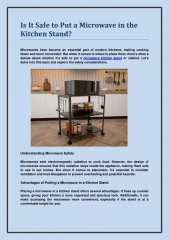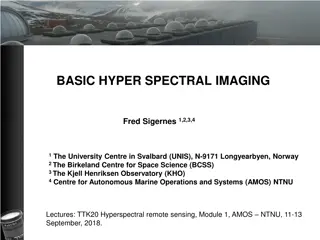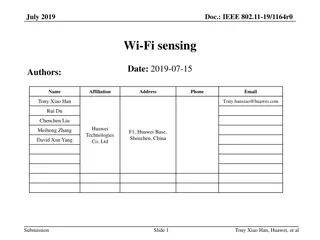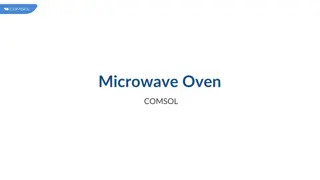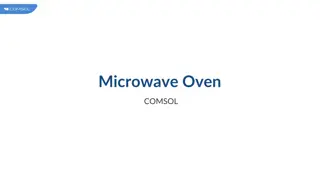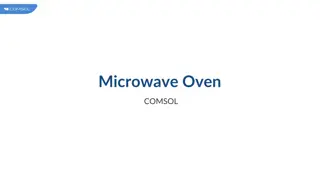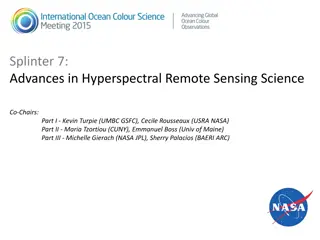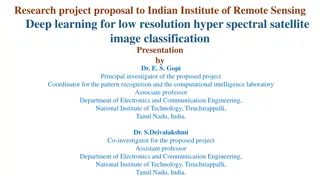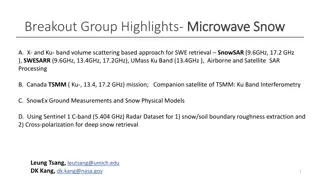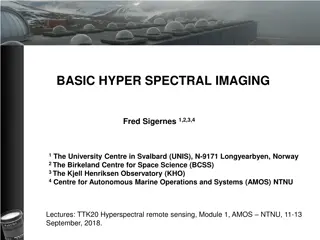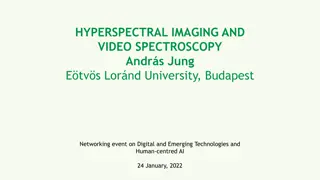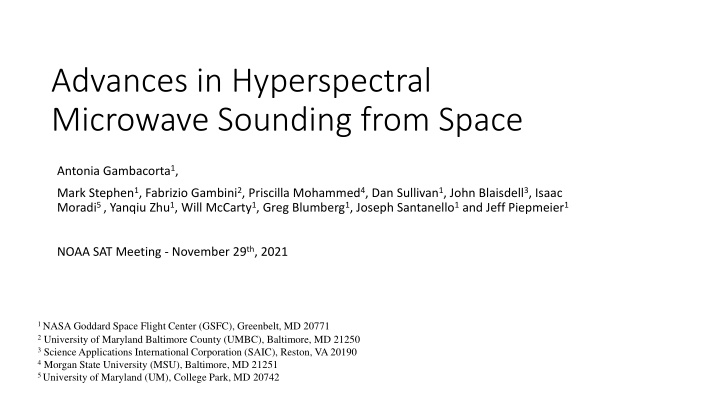
Advances in Hyperspectral Microwave Sensing
Hyperspectral Microwave Measurements for improved environmental data retrieval and forecasting. Presentation on development of a Hyperspectral Microwave Photonic Instrument (HyMPI) with enhanced vertical structure retrieval. Discusses trade studies, motivations, and applications in climate and weather forecasting.
Download Presentation

Please find below an Image/Link to download the presentation.
The content on the website is provided AS IS for your information and personal use only. It may not be sold, licensed, or shared on other websites without obtaining consent from the author. If you encounter any issues during the download, it is possible that the publisher has removed the file from their server.
You are allowed to download the files provided on this website for personal or commercial use, subject to the condition that they are used lawfully. All files are the property of their respective owners.
The content on the website is provided AS IS for your information and personal use only. It may not be sold, licensed, or shared on other websites without obtaining consent from the author.
E N D
Presentation Transcript
Advances in Hyperspectral Microwave Sounding from Space Antonia Gambacorta1, Mark Stephen1, Fabrizio Gambini2, Priscilla Mohammed4, Dan Sullivan1, John Blaisdell3, Isaac Moradi5 , Yanqiu Zhu1, Will McCarty1, Greg Blumberg1, Joseph Santanello1and Jeff Piepmeier1 NOAA SAT Meeting - November 29th, 2021 1 NASA Goddard Space Flight Center (GSFC), Greenbelt, MD 20771 2 University of Maryland Baltimore County (UMBC), Baltimore, MD 21250 3 Science Applications International Corporation (SAIC), Reston, VA 20190 4 Morgan State University (MSU), Baltimore, MD 21251 5 University of Maryland (UM), College Park, MD 20742
Motivations, Trade Studies, Applications Hyperspectral Microwave Measurements have been long advocated by meteorological and space agencies worldwide to improve temperature, water vapor and hydrometeors retrieval from space. Recent advances in Photonic Integrated Circuits (PICs) technology have opened a new era of hyperspectral microwave instrument development. Our team at GSFC has been awarded the development of a Hyperspectral Microwave Photonic Instrument (HyMPI), configured to provide extended, high spectral resolution coverage in the microwave domain of the Earth s thermal radiation. This presentation provides preliminary results showing significant enhancements in the thermodynamic retrieval vertical structure with respect to POR products that can be key to numerous climate and weather forecasting applications, particularly in the PBL. Our goal is to actively engage the science community during this critical trade study phase and seek feedback on product requirements that can help consolidating instrument specifications and its science and applications traceability.
HyMPIs Baseline Configuration RFI window window window window window H2O O2 O2 H2O 23.8 30.4 50 57.3 88.2 92 118.8 165.5. 183.3 204.0 ATMS/TROPICS Channel Frequencies (GHz) HyMPI Frequency Coverage (20 220 GHz) The design presented in [Aires et al., 2015; Aires et al., 2017] was used as a reference design with some augmentation. One of HyMPI s baseline configurations is characterized by continuous spectral coverage along the oxygen absorption lines in the 52.6-57.3 GHz, 63.3-67.9 GHz (spectral resolution 10 MHz), and 113.7-123.7 GHz spectral bands (spectral resolution 20 MHz), used to retrieve the vertical temperature profile. It has full-spectrum coverage in the water vapor absorption line centered in the 173.3-193.3 GHz band (spectral resolution of 40 MHz), used to retrieve the vertical water vapor profile. In addition to 22 window channels from Aires et al., 2015, we have studied the full interstitial window regions. Red bars are regions of Radio Frequency Interference
Brightness Temperature Sensitivity Analysis to Temperature (K/Km) 1-K temperature perturbations in each 1 km-pressure layer of the atmospheric profile have been applied to measure the response in brightness temperature in the oxygen bands (10 20 MHz resolution). For comparison purposes, ATMS and TROPICS spectral channel frequencies are highlighted by blue and green arrows, respectively. Pressure (hPa) 52.8 54.4 55.5 57.3 65.6 53.7 54.9 118.75 (GHz) TROPICS channels ATMS channels 52.6 - 57.3 GHz 63.3 - 67.9 GHz 113.7 - 123.7 GHz HyMPI Temperature Frequency Coverage
Brightness Temperature Sensitivity Analysis to Water Vapor K/(Km) 5% water vapor perturbations in each 1 km-pressure layer of the atmospheric profile have been applied to measure the response in brightness temperature in the water vapor band (40MHz spectral resolution). For comparison purposes, ATMS and TROPICS spectral channel frequencies are highlighted by blue and green arrows, respectively. Pressure (hPa) (GHz) 176.3 178.6 180.3 182.3 184.3 186.3 187.8 190.3 181.5 185.1 ATMS/TROPICS channels HyMPI Water Vapor Frequency Coverage (173.3-193.3 GHz)
Brightness Temperature Analysis a few remarks MW domain spectrally purer than the infrared: the high redundancy is fully exploitable to increase signal to noise, with significant benefits on retrieval performance (see ahead slides 9 and 10). HyMPI will enable an unprecedented fine resolution observations of extended window regions where the water vapor continuum is important. Those measurements will be critical to improve spectroscopy and forward modeling, which in turn will benefit retrieval performance, numerical weather and climate prediction models, and enable new physics discoveries.
Information Content Analysis Water Vapor We perform a singular value decomposition from preliminary ~3000 simulated spectra (land, ocean, clear sky and cloudy scenes), using HyMPI s and the 12 ATMS water vapor and window channels. HyMPI will increase the retrieval water vapor vertical resolution from at least three coarse layers to an effective vertical profile of at least ten layers. HyMPI Noise floor ATMS
Vertical Resolution Study Water vapor Averaging Kernels HyMPI ATMS HyMPI fills the mid- troposphere - 800 hPa gap in the ATMS retrieval vertical resolution and sensitivity. Nearly doubles the retrieval vertical resolution along the full extent of the mid/upper tropospheric column, and Significantly increases both vertical resolution and sensitivity in the PBL. PBL
Retrieval Impact Study RMS Error Performance (Ocean, clear, global sample) HyMPI reduces the POR temperature Root Mean Square (RMS) error (left) by 50% in the PBL and 20% in the mid/upper troposphere. Water vapor RMS error (right) improves by ~50% in the PBL and along the full extent of the mid/upper troposphere. Both improvements, in the PBL and the free troposphere above, will potentially enhance the identification of the PBL height. First Guess 118/183 PBL GHz ATMS HMW
Retrieval Impact Study Bias Error Performance (Ocean, clear, global sample) HyMPI reduces the POR temperature BIAS error (left) by 50% in the PBL. The water vapor BIAS error (right) almost reaches zero in the PBL domain and all along the free troposphere. The improvements shown, both in the PBL and the free troposphere above, will lead to significant enhancement in the identification of the PBL height as well. First Guess 118/183 PBL GHz ATMS HMW
Stratocumulus Cloud Scenario Figure a) is a cloud liquid water profile from the area. Figure b), c), and d) show the first guess, ATMS and ATMS + HyMPI derived water vapor departure from the truth at 875 hPa. HyMPI provides significant enhancement in the water vapor at the top of the PBL. Improved water vapor fields in stratocumulus cloudy scenes are critical for cloud-climate feedbacks and numerical weather prediction.
Conclusive Remarks and Outlook This presentation provides preliminary results showing significant enhancements in the thermodynamic retrieval vertical structure with respect to POR products that can be key to numerous climate and weather forecasting applications, particularly in the PBL. What driving applications (improved and new) can we develop? What are the requirements? Our goal is to actively engage the science community during this critical trade study phase and seek feedback on product requirements that can help consolidating instrument specifications and its science and applications traceability.
RFI window window window window window H2O O2 O2 H2O 23.8 30.4 50 57.3 88.2 92 118.8 165.5. 183.3 204.0 ATMS/TROPICS Channel Frequencies (GHz) HyMPI Frequency Coverage (20 220 GHz)

